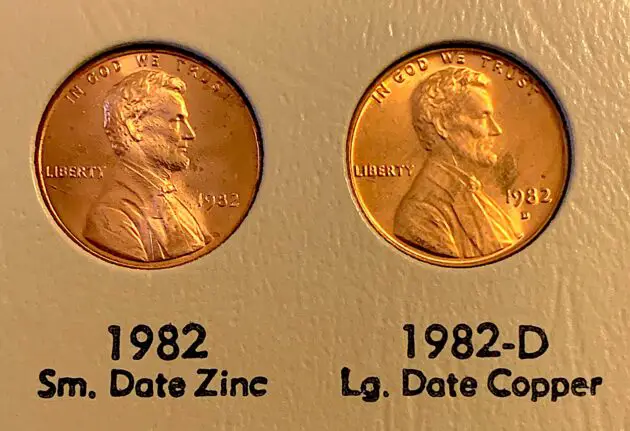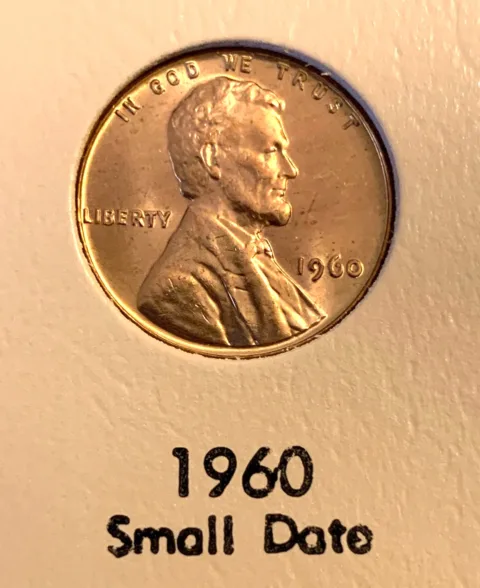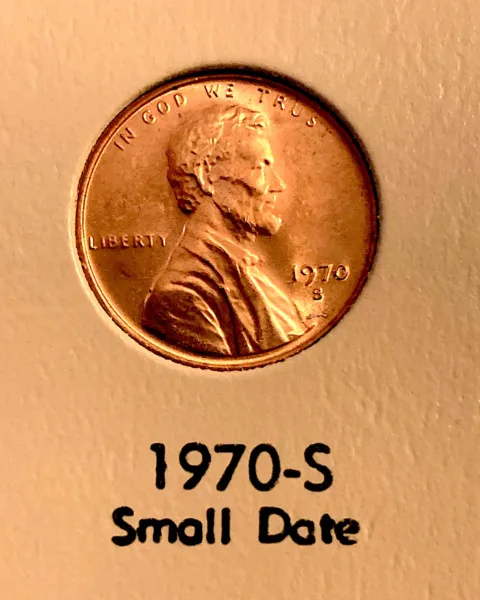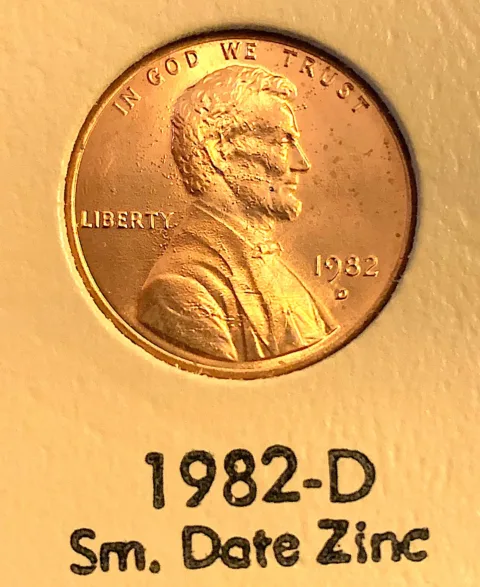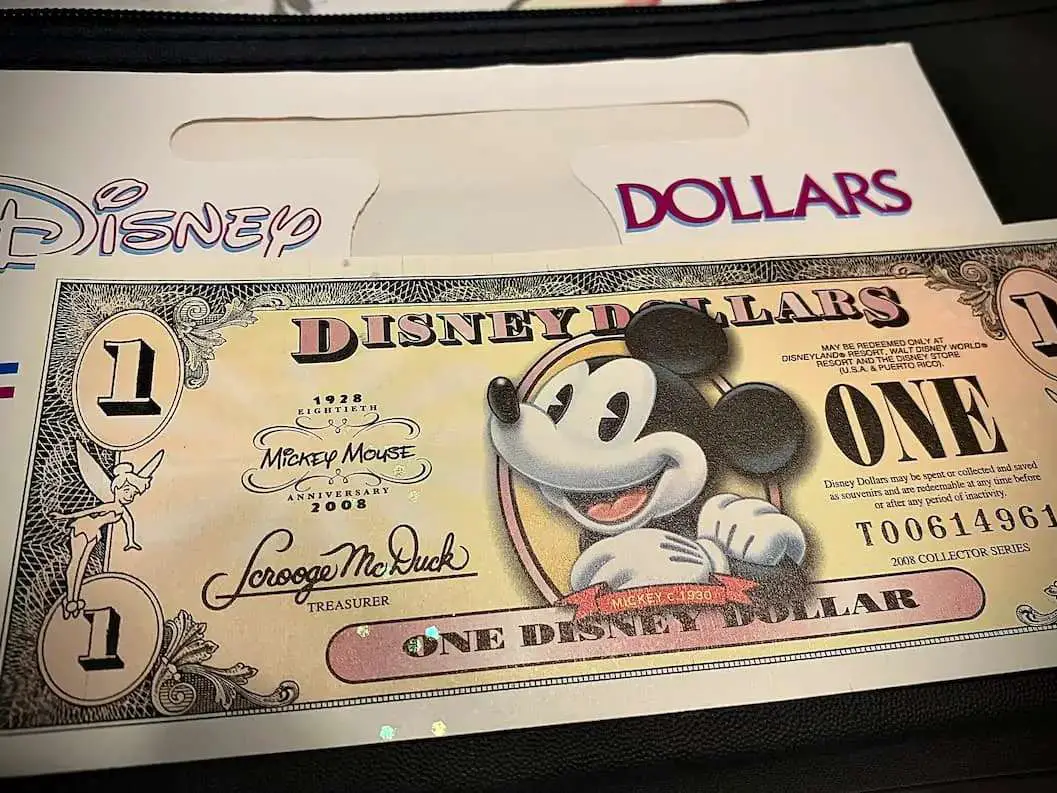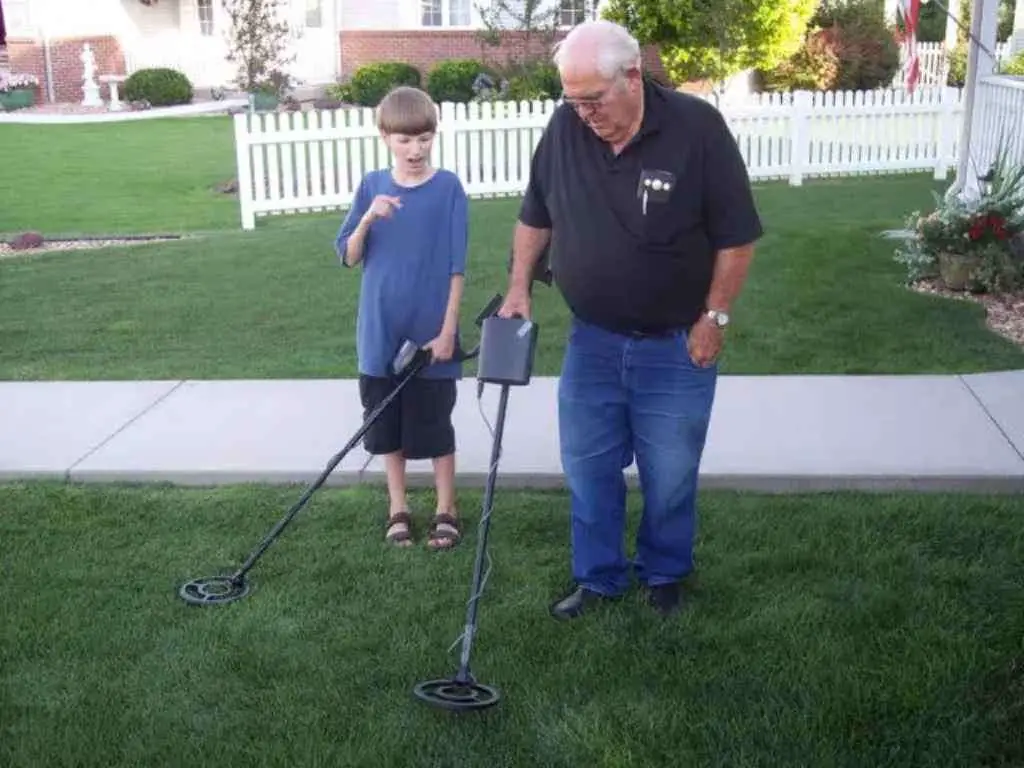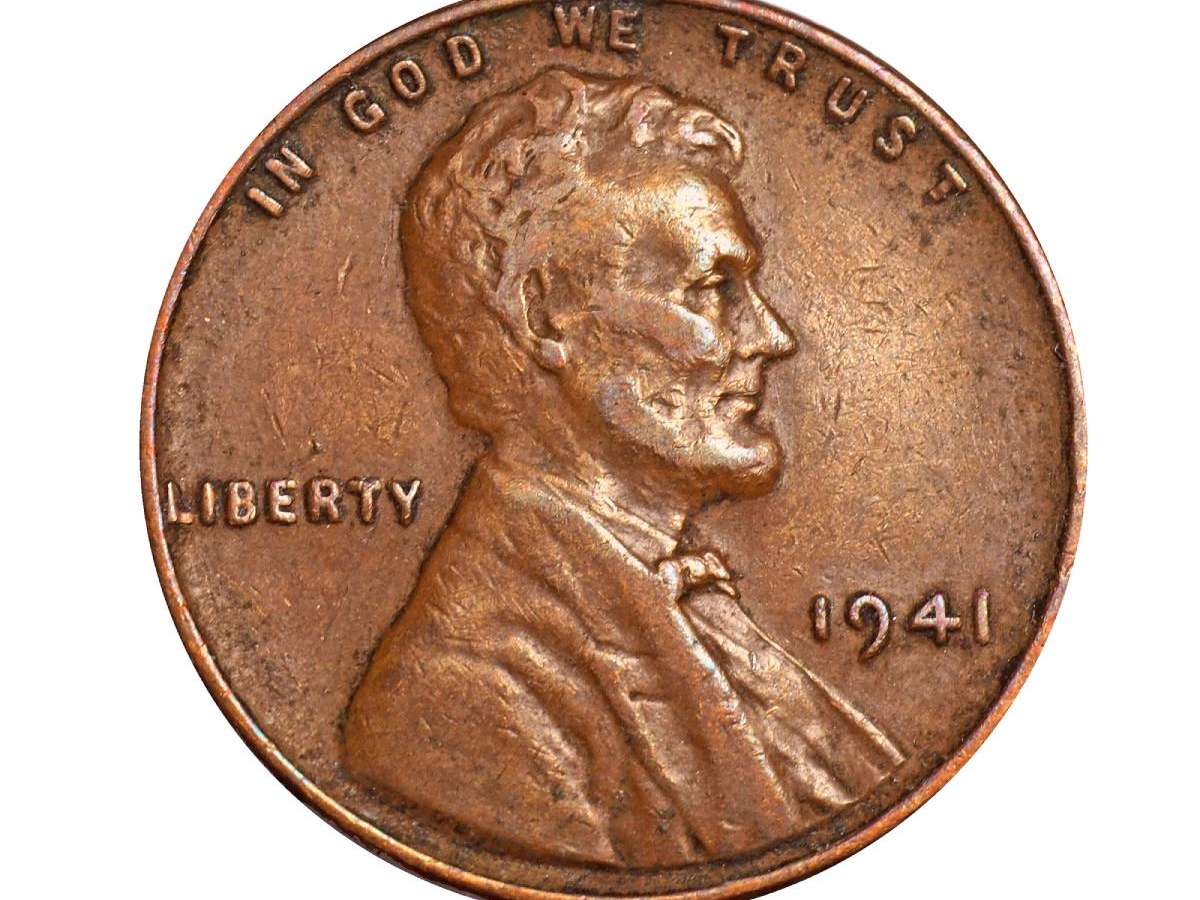Small date pennies and large date pennies are important coins for collectors seeking the different varieties within the Lincoln penny series.
In this picture, you can see the size difference of the date on a 1982 small date penny vs. a 1982 large date penny:
In some cases, the values of these coins are based entirely on whether or not a particular Lincoln cent has a large date or small date.
So, what’s the difference between a small date vs. large date penny?
Quite a lot! But you’ve got to know what you’re looking for.
While large dates and small dates can occur on any coin, they’re most common with the Lincoln Memorial cent series.
In this article, you’re going to learn how to tell the differences between the:
- 1960 small date vs. 1960 large date
- 1960-D small date vs. 1960-D large date
- 1970-S small date vs. 1970-S large date
- 1982 small date (bronze) vs. 1982 large date (bronze)
- 1982-D small date (bronze) vs. 1982-D large date (bronze)
- 1982 small date (zinc) vs. 1982 large date (zinc)
- 1982-D small date (zinc) vs. 1982-D large date (zinc)
Since the date differences are the same for each of the coins within a given year, we are going to break down this post into 3 easily digestible sections:
- 1960 pennies
- 1970 pennies
- 1982 pennies
Once you’re finished reading this, you’ll be able to start looking for and identifying the scarce large date and small date varieties for all of these Lincoln pennies!
1960 Pennies: Small Date vs. Large Date
In 1960, the U.S. Mint made modifications to the size and shape of the numerals in the date for the Lincoln cent.
This was done for Lincoln pennies from both the Philadelphia and Denver Mints. This resulted in the creation of 4 separate varieties for the 1960 pennies, including:
- 1960 large date Lincoln cent
- 1960 small date Lincoln cent
- 1960-D large date Lincoln cent
- 1960-D small date Lincoln cent
How To Tell A 1960 Small Date Penny From A Large Date
One of the biggest giveaways with the 1960 small date and large date pennies is the tops of the numerals:
- If the tops of the “1,” “9,” and “0” are all on the same plane, you’ve got a 1960 small date penny.
- If the “9” pops up higher than the “1,” then you’ve got a 1960 large date penny.
How Much Are 1960 Pennies Worth?
The value of most 1960 pennies is pretty easy to determine.
Here’s how much most 1960 Lincoln cents are worth:
- If they’re circulated, then they’re worth about 2 cents for their copper content value.
- Uncirculated 1960 Lincoln cents start at around 30 to 50 cents.
- Proof 1960 Lincoln pennies are worth about $1 and up.
The rarest of the 1960 pennies is the small date from the Philadelphia Mint, not showing a mintmark.
Here’s how much a 1960 small date penny is worth:
- The 1960 small date Lincoln cent is worth at least $3 to $5 in uncirculated condition and $20 or more in nicer uncirculated grades.
1970 Pennies: Small Date vs. Large Date
The 1970 Lincoln pennies are pretty common. You’ve probably seen them in your pocket change from time to time and perhaps have some in a coin jar.
But at least one type of 1970 penny is scarcer than others.
The rarest of the regular-issue 1970 pennies is the small date from the San Francisco Mint (“S” mintmark). The 1970-S small date penny is one of the toughest small-date pennies to find. It’s unknown how many were made, but most numismatic experts believe the number is relatively small.
How To Tell A 1970-S Small Date Penny From A Large Date
There are a couple major diagnostics for attributing a 1970-S small date Lincoln cent:
- If the tops of the “1,” “9,” “7,” and “0” numerals in the date are all aligned on the same invisible plane, then you’ve got a 1970 small date penny.
- The 1970-S small date penny is notorious for a lightly struck “LIBERTY” on the left side of the obverse. (You probably shouldn’t use this as the sole indicator of whether you have a 1970-S small date penny though — because surely some large dates have been struck with a weaker-than-usual “LIBERTY.” But if you think the numerals on your 1970-S penny show the small date features and you see a weak “LIBERTY” on the coin, then you can be pretty confident you’ve got the 1970 small date Lincoln cent.
How Much Are 1970 Pennies Worth?
If you find a 1970-S small date Lincoln cent in your pocket change, be sure to save it!
Here’s how much 1970-S small date pennies are worth:
- In worn grades, a 1970-S small date penny is worth about $3 to $5.
- In uncirculated grades, a 1970-S small date penny is worth $25 or more.
- Proof versions of the 1970-S small date penny are worth around $20 and up.
As for other 1970 pennies, there are only large date and small varieties among the 1970-S — not the Philadelphia or Denver pieces. So you won’t need to look for any differences among the non-S mintmark 1970 Lincoln cents.
Here’s how much most 1970 Lincoln cents are worth:
- 1970 Lincoln cents in worn condition are worth 2 cents each.
- In uncirculated condition, 1970 pennies (including the 1970-S large date) are worth about 10 to 15 cents.
- 1970-S large date proofs are worth around $1 and up.
1982 Pennies: Small Date vs. Large Date
The coin that so many people want to know about is the 1982-D bronze small date penny.
It’s not only among the rarest of modern coins, but it’s also one of the most valuable. Only 2 have been found — and they sell for about $15,000 each!
See the 1982-D small date penny below?
Yes, I know… it’s not the super rare bronze penny.
But it’s what a 1982-D small date looks like — whether zinc or bronze.
How To Tell A 1982-D Small Date Penny From A Large Date
- In that photo above, notice how the tops of the numerals “1,” “9,” “8,” and “2” all align? That’s one major diagnostic for determining a 1982 small date penny.
- Another diagnostic? The shape of the “2” in the date. The “2” in the 1982 small date penny has a slight curvy shape in the main diagonal stem — whereas on the 1982 large date penny, it is much straighter.
What About Bronze Versus Zinc 1982 Pennies?
Our main topic of conversation here is the discussion of small dates versus large dates. But the 1982-D bronze small date Lincoln cent is such a rarity that it deserves a bit more background on how to determine if you’ve got one.
There are 3 ways to tell a 1982 bronze penny versus a zinc one:
- Weigh it. A bronze Lincoln cent weighs about 3.11 grams. However, due to natural tolerances an example may weigh anywhere from about 2.98 grams to 3.24 grams.
- A copper-plated zinc penny should weigh approximately 2.5 grams. Some examples may register at 2.4 to 2.6 grams.
- Another way to tell a copper 1982 Lincoln cent versus a zinc is to drop it on a hard table. If you hear a slight, warm ringing noise (like a tiny bell) when you drop it, it’s a bronze cent. Does it click? It’s zinc. It may take a bit of practice to get the bronze versus zinc determination correct this way — but it’s right every time!
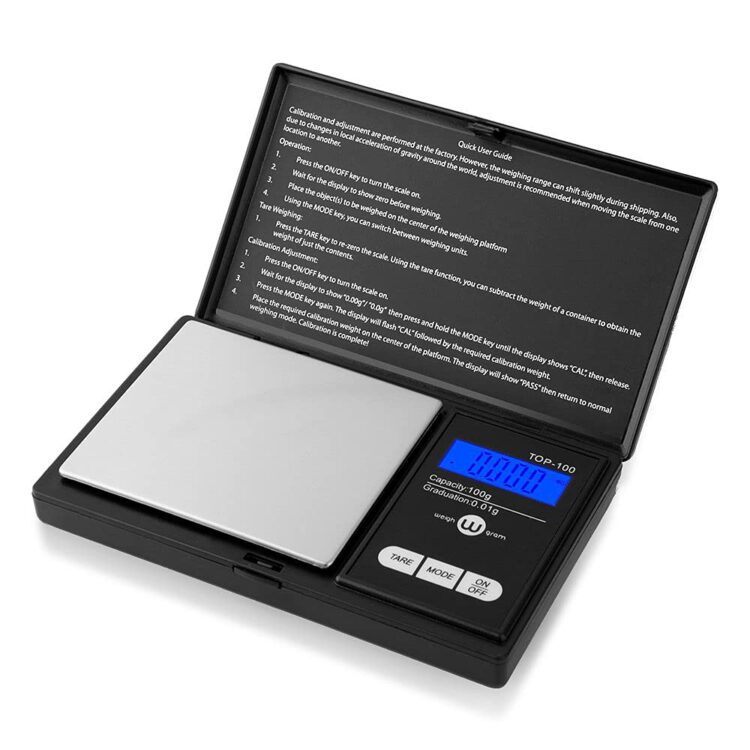
I like the Weigh Gram coin scale best.
How Much Are 1982 Pennies Worth?
The 1982-D bronze small-date Lincoln cent is one of the most expensive of all Lincoln Memorial cents.
Here’s how much 1982-D bronze small date pennies are worth:
- The two 1982-D bronze small-date Lincoln cents that have sold to date are both in About Uncirculated condition. The first example of this transitional error sold for $18,800 in 2017 while the second sold for $8,400 in 2019. If others turn up in similar condition, they could be worth anywhere from $5,000 to $10,000 or more.
There are 8 other major types of 1982 pennies:
- 1982 bronze large date
- 1982 bronze small date
- 1982 zinc large date
- 1982 zinc small date
- 1982-D bronze large date
- 1982-D zinc large date
- 1982-D zinc small date
- 1982-S proof
These other 1982 pennies are generally worth much less than the Denver-minted bronze small date.
Here’s how much most 1982 Lincoln cents are worth:
- All regular-issue, non-error circulated 1982 bronze pennies are worth about 2 cents each for their copper value.
- Uncirculated 1982 bronze pennies are worth about 15 cents and up.
- Circulated 1982 zinc pennies are worth face value, unless they feature an error or variety.
- Uncirculated 1982 zinc Lincoln cents are worth about 10 cents and up.
- The 1982-S proof Lincoln cent is struck in bronze and has no known large or small date variants. These are worth about $2 and up.
I’m the Coin Editor here at TheFunTimesGuide. My love for coins began when I was 11 years old. I primarily collect and study U.S. coins produced during the 20th century.
I’m a member of the American Numismatic Association (ANA) and the Numismatic Literary Guild (NLG) and have won multiple awards from the NLG for my work as a coin journalist. I’m also the editor at the Florida United Numismatists Club (FUN Topics magazine), and author of Images of America: The United States Mint in Philadelphia (a book that explores the colorful history of the Philadelphia Mint). I’ve contributed hundreds of articles for various coin publications including COINage, The Numismatist, Numismatic News, Coin Dealer Newsletter, Coin Values, and CoinWeek.
I’ve authored nearly 1,000 articles here at The Fun Times Guide to Coins (many of them with over 50K shares), and I welcome your coin questions in the comments below!

